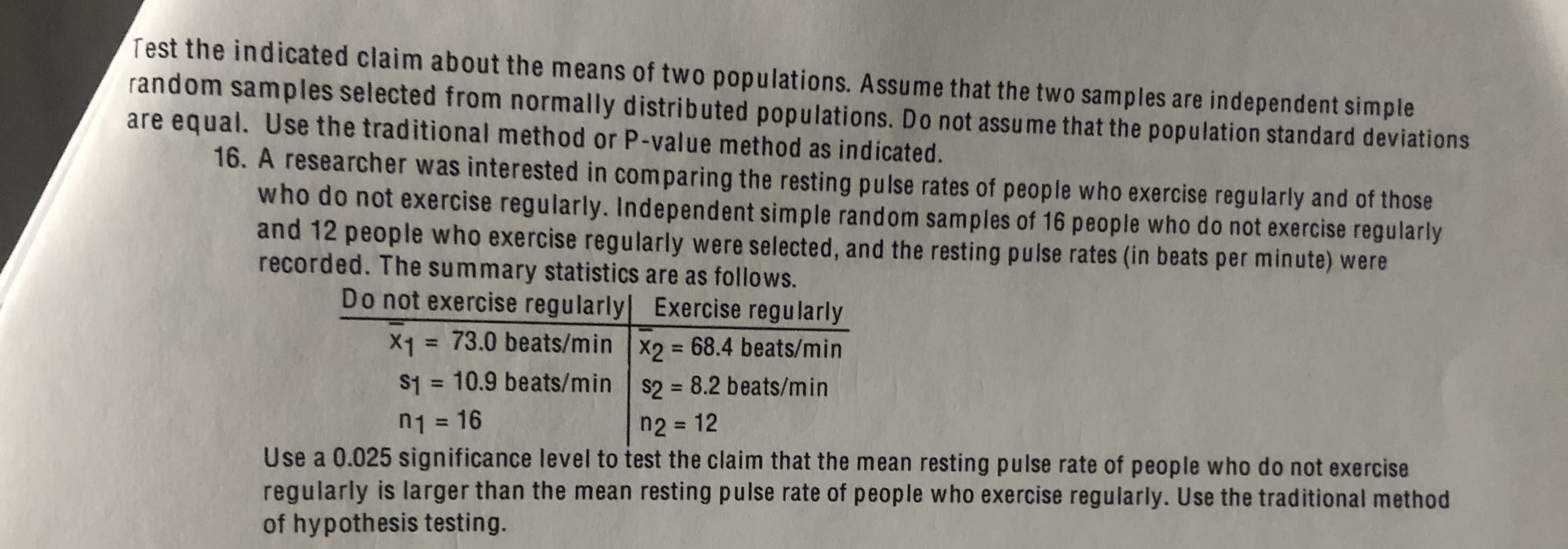Test the indicated claim about the means of two populations. Assume that the two samples are independent simple random samples selected from normally distributed populations. Do not assume that the population standard deviations are equal. Use the traditional method or P-value method as indicated. 16. A researcher was interested in comparing the resting pulse rates of people who exercise regularly and of those who do not exercise regularly. Independent simple random samples of 16 people who do not exercise regularly and 12 people who exercise regularly were selected, and the resting pulse rates (in beats per minute) were recorded. The summary statistics are as follows. Do not exercise regularly Exercise regularly X1 = 73.0 beats/min X2 68.4 beats/min S1 = 10.9 beats/min s2 = 8.2 beats/min %3D %3D %3D n2 = 12 n1 = 16 %3D Use a 0.025 significance level to test the claim that the mean resting pulse rate of people who do not exercise regularly is larger than the mean resting pulse rate of people who exercise regularly. Use the traditional method of hypothesis testing.
Test the indicated claim about the means of two populations. Assume that the two samples are independent simple random samples selected from normally distributed populations. Do not assume that the population standard deviations are equal. Use the traditional method or P-value method as indicated. 16. A researcher was interested in comparing the resting pulse rates of people who exercise regularly and of those who do not exercise regularly. Independent simple random samples of 16 people who do not exercise regularly and 12 people who exercise regularly were selected, and the resting pulse rates (in beats per minute) were recorded. The summary statistics are as follows. Do not exercise regularly Exercise regularly X1 = 73.0 beats/min X2 68.4 beats/min S1 = 10.9 beats/min s2 = 8.2 beats/min %3D %3D %3D n2 = 12 n1 = 16 %3D Use a 0.025 significance level to test the claim that the mean resting pulse rate of people who do not exercise regularly is larger than the mean resting pulse rate of people who exercise regularly. Use the traditional method of hypothesis testing.
Glencoe Algebra 1, Student Edition, 9780079039897, 0079039898, 2018
18th Edition
ISBN:9780079039897
Author:Carter
Publisher:Carter
Chapter10: Statistics
Section10.4: Distributions Of Data
Problem 19PFA
Related questions
Question

Transcribed Image Text:Test the indicated claim about the means of two populations. Assume that the two samples are independent simple
random samples selected from normally distributed populations. Do not assume that the population standard deviations
are equal. Use the traditional method or P-value method as indicated.
16. A researcher was interested in comparing the resting pulse rates of people who exercise regularly and of those
who do not exercise regularly. Independent simple random samples of 16 people who do not exercise regularly
and 12 people who exercise regularly were selected, and the resting pulse rates (in beats per minute) were
recorded. The summary statistics are as follows.
Do not exercise regularly Exercise regularly
X1 = 73.0 beats/min X2 68.4 beats/min
S1 = 10.9 beats/min s2 = 8.2 beats/min
%3D
%3D
%3D
n2 = 12
n1 = 16
%3D
Use a 0.025 significance level to test the claim that the mean resting pulse rate of people who do not exercise
regularly is larger than the mean resting pulse rate of people who exercise regularly. Use the traditional method
of hypothesis testing.
Expert Solution
This question has been solved!
Explore an expertly crafted, step-by-step solution for a thorough understanding of key concepts.
This is a popular solution!
Trending now
This is a popular solution!
Step by step
Solved in 4 steps with 3 images

Recommended textbooks for you

Glencoe Algebra 1, Student Edition, 9780079039897…
Algebra
ISBN:
9780079039897
Author:
Carter
Publisher:
McGraw Hill

Glencoe Algebra 1, Student Edition, 9780079039897…
Algebra
ISBN:
9780079039897
Author:
Carter
Publisher:
McGraw Hill